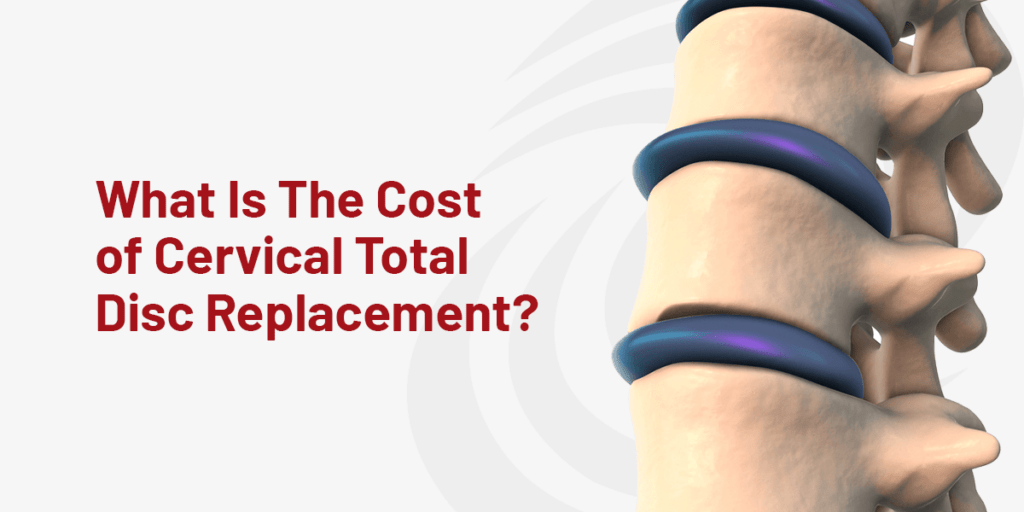
Are you considering cervical artificial disc replacement (ADR) but feeling uncertain about the costs and insurance coverage? You’re not alone. The expenses associated with this procedure can range widely—from $30,000 to $50,000 per disc. Several factors, such as location, hospital fees, surgeon expertise and the type of disc implanted, affect this price.
Navigating insurance policies and understanding whether Medicare covers the surgery can add another layer of complexity. In this comprehensive guide, we’ll break down everything you need to know about the costs involved, how insurance and Medicare come into play and what factors can affect your out-of-pocket expenses.
Let’s start with the vital information — what exactly does the total price of an ADR include? Usually, the price includes the following:
The majority of insurance companies cover some or all of the costs associated with cervical disc replacement surgery. Reach out to your insurance company to get more information about your policy’s restrictions and coverage details. To qualify for insurance coverage, you need to meet certain requirements:
If you have health insurance, the out-of-pocket cost can be significantly lower, depending on your plan’s coverage, whether it’s deductible in-network or out-of-network and coinsurance. Without insurance, you would need to pay the entire cost out of pocket. It’s also worth noting that costs can be lower in other countries where medical procedures are less expensive. However, this comes with other considerations, such as travel and potential differences in care standards.
The total cost of cervical artificial disc replacement (ADR) can vary significantly based on several factors, including:
Medicare may cover the cost of cervical disc replacement in some areas via Local Coverage Determinations (LCD). To get accurate information, you should reach out to your local Medicare representative, as specific requirements can vary by area.
However, Medicare coverage for cervical disc replacement may have age restrictions. Patients over 60 years old might not be eligible for coverage, while those 60 and under may receive coverage after meeting an LCD. Regardless of your age, the Desert Institute for Spine Care can assist you in finding the right local insurance coverage option for you.
As with any major medical decision, one must weigh out the cost, time and effort needed to proceed with surgery. What follows are some suggestions of what to consider when looking at the cost of cervical artificial disc surgery:
Most people who are considering cervical ADR want to know what to expect in terms of the associated costs, which is why we’ve gathered five of the most commonly asked questions about this procedure.
For those suffering in pain who have had a cervical artificial disc replacement, the answer is YES! The satisfaction rate seven years after the initial surgery was 88%. The value of one’s quality of life is often immeasurable, especially when suffering from pain and being out of work.
The cervical disc may have slightly more upfront cost than the cervical fusion. However, the artificial disc’s long-term cost-effectiveness becomes evident versus cervical spine fusion when considering cost savings from fewer complications, reoperations and additional treatments.
Artificial disc replacement is a more effective long-term value than spinal fusion in the neck. From a strictly cash price, ACDF spinal fusion is slightly less expensive than a cervical artificial disc replacement. However, recovery time after an artificial disc replacement is notably faster than after a spinal fusion.
Patients who undergo cervical disc replacement retain neck mobility, which is the primary reason for their quicker recovery. In the long term, patients undergoing cervical disc replacement have fewer complications, lower reoperation rates and higher satisfaction rates.
Insurance coverage for cervical artificial disc replacement can vary depending on the insurance provider and the specific plan. Many insurance companies do cover the procedure, but they often require that certain criteria be met, such as evidence of failed conservative treatments and medical necessity. It’s important to check with your insurance provider to understand your coverage details, any pre-authorization requirements and potential out-of-pocket costs.
Same-day/outpatient cervical artificial disc surgery might be less expensive than traditional inpatient surgery because it often involves fewer hospital resources and a shorter hospital stay. In a same-day or outpatient setting, you avoid the costs associated with overnight stays and extended care.
However, the overall cost can still be influenced by factors such as the surgeon’s fees, facility fees and the complexity of the procedure. It’s a good idea to check with your healthcare provider and insurance company to get a detailed breakdown of the costs and any potential savings.
Understanding the cost of cervical artificial disc replacement and how it fits into your financial and insurance planning can be daunting. However, being informed and proactive about the various factors that influence the total cost can help you make the best decisions for your health and finances.
By thoroughly reviewing your insurance policy, obtaining detailed estimates and exploring financial assistance options, you can better manage the expenses associated with this procedure. Remember, your health and well-being are invaluable, and taking the time to navigate these financial considerations can lead to a more informed and confident choice about your care.
At Desert Institute for Spine Care, we specialize in cervical artificial disc replacement. We’re located in Phoenix, Arizona, and our team of experts has over 50 years of patient experience between them.
If you have any further questions or need assistance, don’t hesitate to reach out to us at Desert Institute for Spine Care or insurance representative for guidance.